Oxygen is the giver of life!
– Otto Warburg, winner of the Nobel Prize in Physiology (1931).
An important characteristic of both aging and disease is a lack of energy at the cellular level. One of the main reasons for this lack of energy is a corresponding lack of oxygen. As we age, cardiac output declines, and with it, the amount of oxygen that can be delivered to our cells. Disease and other forms of biological stress can also induce hypoxia. Surprisingly, even relatively brief hypoxic events can trigger chronic hypoxia that persists long after the original cause is gone.
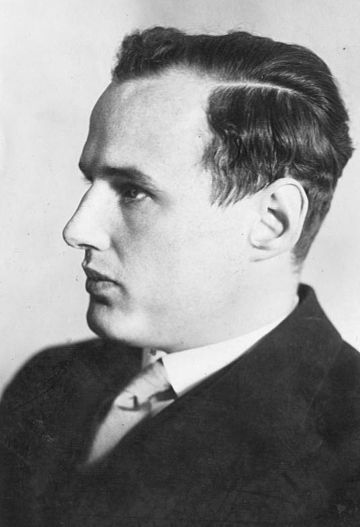
Fortunately, due to the work of Manfred von Ardenne (left), as published in his 1990 book Oxygen Multistep Therapy (O2MT), chronic hypoxia can often be reversed, in a durable way. Once reversed, your energy status will improve, and as your energy status improves, so will your health.
Ardenne (1907-1997) was a fascinating person. Born in Hamburg, Germany, he later lived in Berlin, then lived and worked in the Soviet Union during and after WWII, and eventually settled in Dresden, East Germany. He was a physicist and prolific inventor. He invented the scanning electron microscope and the fundamentals of television, among many other things. He held around 600 patents.
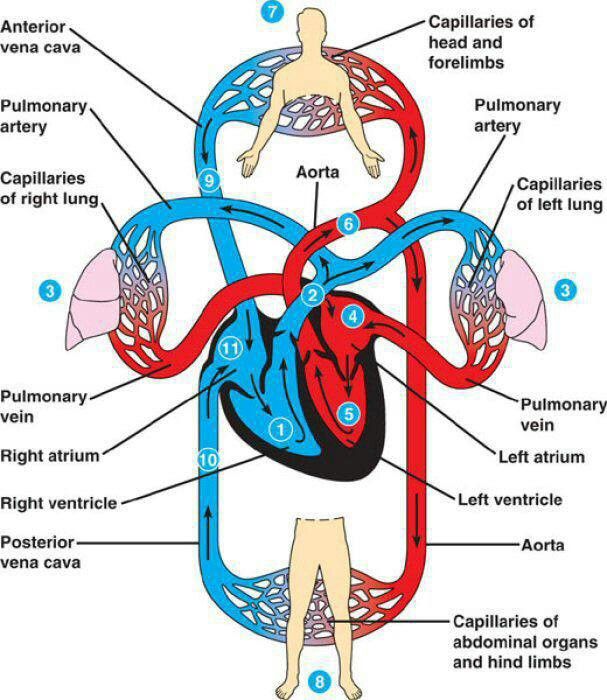
To understand more about how O2MT works and the conditions it's intended to treat, let's start with the circulatory system.
The heart pumps oxygen-depleted blood to the lungs, which replenish the oxygen and allow carbon dioxide to escape. The oxygen-rich blood goes back to the heart, and is pumped from there to the rest of the body, where it releases the oxygen, collects carbon dioxide, and then returns to the heart to begin the process again.
In both your lungs and the rest of your body, these gas exchanges happen inside capillaries that are just big enough for red blood cells to fit. Red blood cells pass through the capillaries "single file," and either receive (in the lungs) or give up (in the body) their oxygen.
Most of the oxygen in the blood is carried by hemoglobin, inside red blood cells. However, a small but important fraction (roughly 2%) is also dissolved in the plasma. Although most of the body gets its oxygen from hemoglobin, there are a few tissues that get it from the plasma instead. That includes cartilage, vocal cords, the lens of the eye, and the cells of the blood vessels.
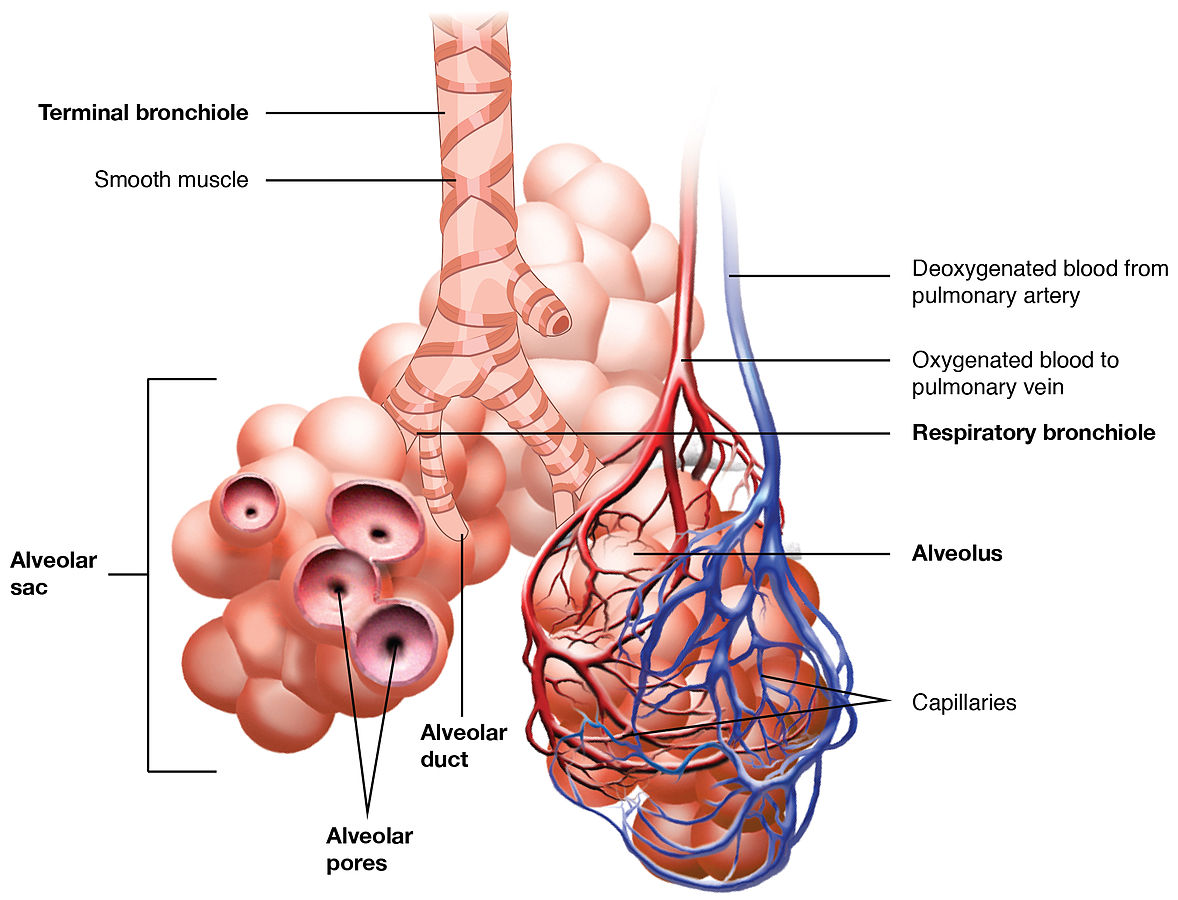
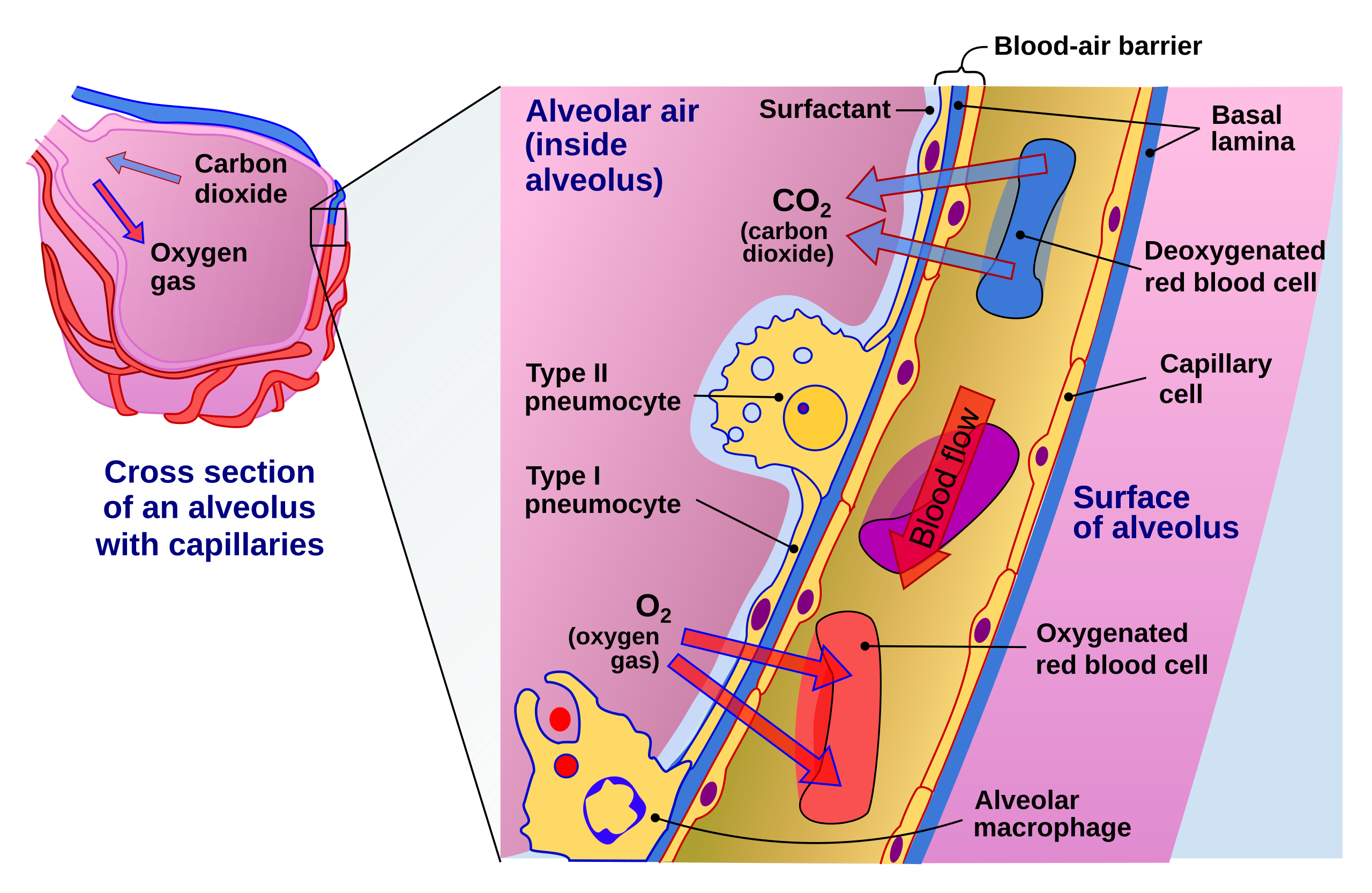
Air contains 21% oxygen. As you inhale, it's carried deep into your lungs where it inflates small sacs called alveoli. Capillaries are wrapped around the alveoli. A single alveolus and capillary together form a membrane just a few cells thick that separates the air from the blood. That layer of cells is so thin that oxygen can pass through it in one direction, and carbon dioxide in the other. The incoming oxygen first dissolves into the plasma, and moves from there into the red blood cells, where it binds with hemoglobin.
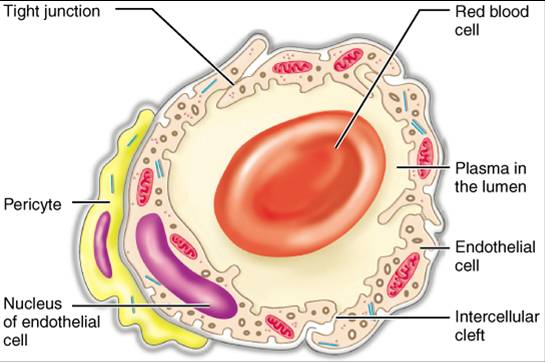
A cross-section of a capillary is shown in the drawing to the left. The large red oval in the middle is a red blood cell. The wall of the capillary is comprised of endothelial cells. The center area is called the lumen, and contains plasma, along with the red blood cell.
As blood moves through the capillary, the gas exchange process is continuous. In the tissues, it begins at the arterial, oxygen-rich side, and ends at the venous, oxygen-poor side. The endothelial cells need oxygen, just like all cells do. However, as mentioned above, they get their oxygen from the plasma, not from hemoglobin. This fact has important implications. If the amount of oxygen dissolved in the plasma gets too low, the cells at the venous end of the capillaries can become hypoxic.
When the endothelial cells don't have enough oxygen, they can't produce the energy they need. One of the energy-consuming processes in those cells is the sodium-potassium pump. This is a chemical pump that moves sodium out of the cell, and moves potassium into the cell. When that pump begins to fail, it causes the affected cells to absorb water and become swollen (edema). Since the plasma at the venous end of the capillaries is where oxygen reaches its lowest level, the cells there are the first to swell when this happens.
When the endothelial cells are swollen, they reduce blood flow through the capillary. Less blood flow means less oxygen.
Ardenne discovered that this swelling process works like a switch; once it's triggered, cells tend to remain swollen, even when normal oxygen levels are restored. This happens because the swelling itself interferes with the blood and oxygen flow, both in the capillaries and into the cell itself, so it becomes a self-reinforcing problem. The restricted blood flow means the cells can't get the oxygen they need to function properly again.
Fortunately, Ardenne also discovered an effective treatment. The idea begins with super-saturating the blood with oxygen, well above normal levels. Then, while that's happening, get the heart beating fast. When blood is pumped more quickly through the capillaries while it's in a super-saturated state, more oxygen will be available at the venous end of the capillary. As the endothelial cells absorb and begin to use that oxygen, their sodium-potassium pumps begin working again, cell swelling decreases, oxygen delivery to tissues improves, and body-wide energy status normalizes. This technique is what Ardenne called Oxygen Multistep Therapy (O2MT). The effect is shown in the diagram below.
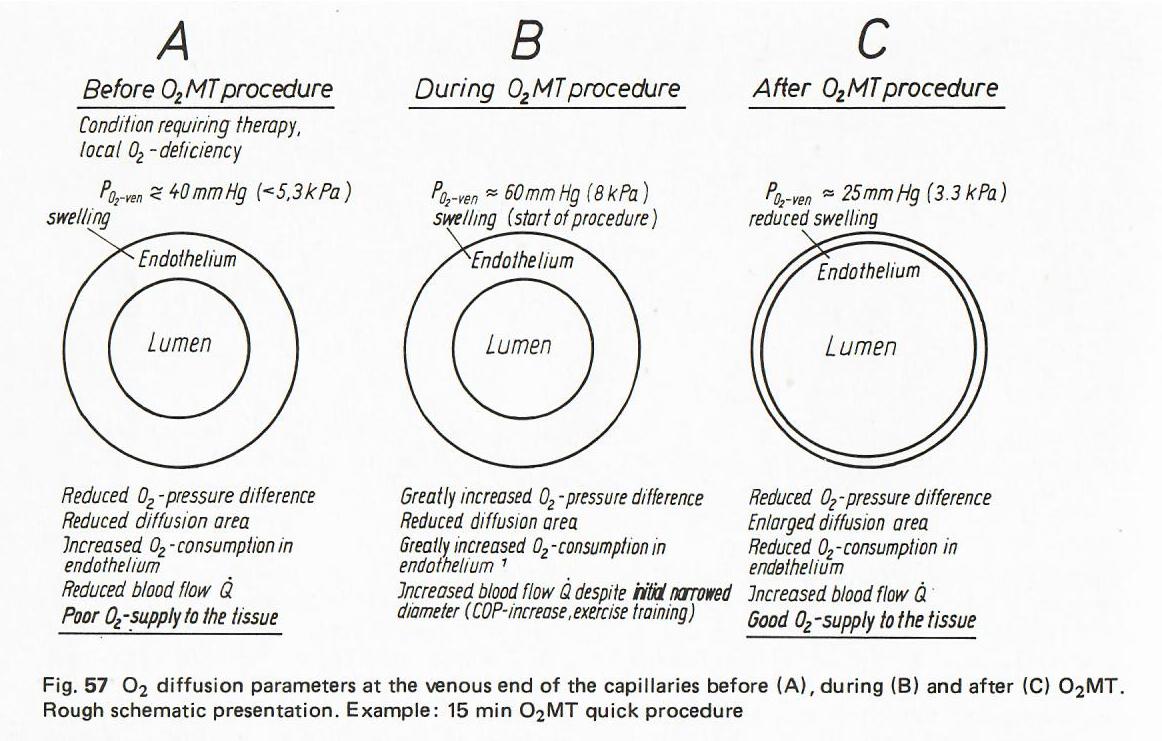
In the diagram, Figures A and B show the swollen endothelium before and during the O2MT procedure. Afterwards, Figure C shows the swelling is reduced; normal blood flow and gas exchange is restored.
The amount of oxygen dissolved in plasma is called pO2. Ardenne calls the amount in the arterial side of the capillary pO2-art. In more recent books and papers, you might see it called paO2 or pO2(a). On the venous side, it's pO2-ven or pvO2 or pO2(v). It's measured as a partial pressure, in millimeters of mercury (mm Hg).
One of the characteristics of what we could call the swollen capillary endothelium syndrome is the amount of oxygen used by the tissue is measurably reduced. In particular, paO2 goes down, but pvO2 increases. This is a result of the process described above: less oxygen is absorbed from the plasma after it has finished passing through the capillary.
Even though the total amount of oxygen dissolved in plasma is relatively small, paO2 is actually a more sensitive measure of blood oxygen status than oxygen saturation (called sO2 or spO2). The latter measures the percentage of arterial hemoglobin that's bound to oxygen. It's an easy at-home measurement to make these days, using a small fingertip oxygen saturation meter. You can see how one measurement relates to the other in the table of estimates below. Note that the relationship between the numbers isn't constant; factors such as temperature and pH can change things.
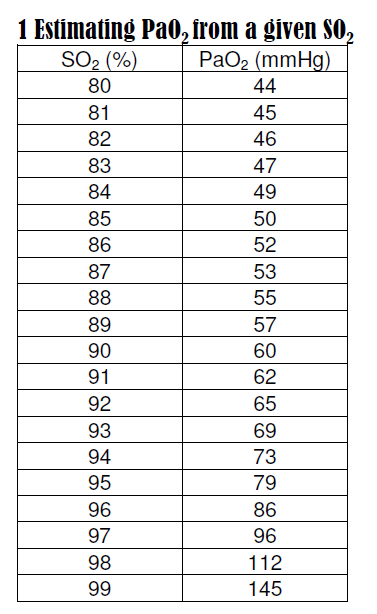
Small changes in sO2 are associated with small changes in paO2 when sO2 is low, but large changes in paO2 when sO2 is high. This is important because for most of us, while breathing normal room air, our sO2 will be reasonably high (typically 92 to 97%). This shows how much room we have on the upside when breathing oxygen-enriched air. For example, just going from 97% sO2 to 99% involves a 51% increase in the amount of oxygen dissolved in plasma. That large increase is an important part of what O2MT relies on to drive oxygen to those hypoxic and swollen capillary endothelial cells.
Exercise is the other half of the equation. Lots of oxygen in the plasma isn't enough by itself; we also need to push that plasma through those narrowed capillaries to enable the hypoxic endothelial cells to absorb what they need to recover. The way to do that is through exercise. Ardenne established a target heart rate of 180 minus your age. For a 30 yr old, that would be 150 beats per minute. The specific form of exercise doesn't matter.
Ardenne developed around 20 different O2MT protocols, for use with different conditions. The most generally useful is what he calls the "quick procedure." This consists of breathing 90%+ oxygen at a flow rate of 25 to 30 L/min, while exercising, for 15 minutes. He also suggested taking certain supplements before and after the treatment: Vitamin B1 (thiamine), Magnesium orotate, and dipyridamole. Dipyridamole increases oxygen uptake and utilization in the brain. In higher doses, it also provides roughly a 5% increase in circulation, lasting about 90 minutes. Modern practitioners of O2MT generally agree that the supplements are optional, and that dipyridimole is not necessary.
An interesting and surprising feature of the O2MT quick procedure is that it often only needs to be done one to three times. Once triggered back to normal, the switching effect for many people is durable. However, a subsequent illness or injury that depletes oxygen and energy reserves can cause to the condition to recur. I am also aware of people with long-standing conditions whose hypoxic state, while not completely irreversible, tends to revert to normal much more slowly, requiring more frequent treatment (1 to 5 days/week) over the long-term. This is also true for those who have been unable to resolve all sources of ongoing chronic biological stress. In addition, those who are unable to tolerate exercise can take much longer to reverse their hypoxic state and heal, and may require pharmacological aids to help them progress.
Chronic hypoxia can affect every organ and system in the body, including the brain. It should therefore come as no surprise that O2MT has a wide range of indications and conditions that it has the potential of improving. Cataracts are noteworthy in that respect, since the lens of the eye is one of the few other parts of the body that gets its oxygen from plasma. In addition, since cardiac output and overall oxygen status decline with age, it turns out that O2MT can be used as a specific and targeted treatment for aging and the diseases it brings.